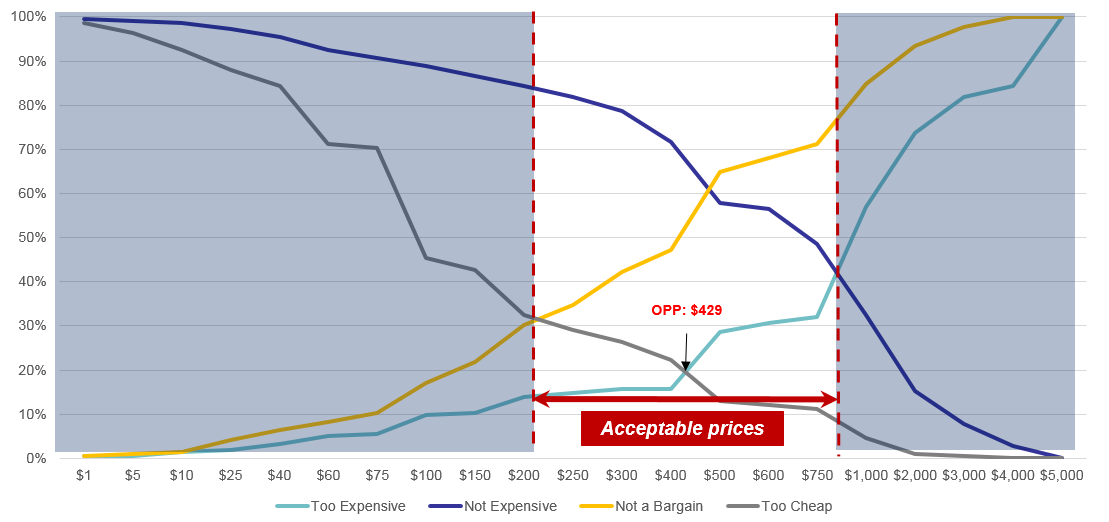The Role of Market Research in Defining Optimal Pricing: Exploring the Van Westendorp Price Sensitivity Meter
Pricing is a critical aspect of any business strategy, directly influencing profitability, market positioning, and customer perception. The right price can attract and retain customers, while an ill-conceived price can drive them away or leave money on the table. To navigate these challenges, businesses often turn to market research to find the optimal pricing strategy. Among the various tools available, the Van Westendorp Price Sensitivity Meter (PSM) is a popular method for understanding consumer price perceptions and determining optimal price points.
The Importance of Market Research in Pricing
Market research plays a pivotal role in pricing decisions by providing insights into consumer behaviour, preferences, and willingness to pay. Understanding these elements helps businesses set prices that maximise revenue without alienating customers. Market research encompasses various methodologies, including surveys, focus groups, competitive analysis, and more sophisticated tools like conjoint analysis and the Van Westendorp PSM.
The primary objectives of market research in pricing are to:
- Identify Customer Segments: Different segments may value the same product differently, necessitating varied pricing strategies.
- Understand Price Elasticity: Knowing how sensitive customers are to price changes helps in setting prices that optimise revenue.
- Gauge Competitive Landscape: Understanding competitors’ pricing helps position products effectively in the market.
- Determine Willingness to Pay: Directly asking customers about their willingness to pay can provide a clear benchmark for setting prices.
The Van Westendorp Price Sensitivity Meter
The Van Westendorp PSM is a quantitative market research technique developed by Dutch economist Peter van Westendorp in the 1970s. It helps businesses understand consumer price perceptions and find an acceptable price range for a product or service. The method involves asking respondents four key questions about the price of a product:
- At what price would you consider the product to be so expensive that you would not consider buying it? (Too expensive)
- At what price would you consider the product to be so inexpensive that you would feel the quality couldn’t be very good? (Too cheap)
- At what price would you consider the product to be starting to get expensive, but you would still consider buying it? (Expensive/high side)
- At what price would you consider the product to be a bargain—a great buy for the money? (Cheap/good value)
These questions are designed to assess consumer price sensitivity and identify four key points:
- Optimal Price Point (OPP): The price at which the number of respondents who perceive the price as “too expensive” equals the number who perceive it as “too cheap.”
- Indifference Price Point (IPP): The price at which an equal number of respondents consider the price to be a good deal and starting to get expensive.
- Point of Marginal Cheapness (PMC): The price below which consumers start doubting the product’s quality.
- Point of Marginal Expensiveness (PME): The price above which the product is considered too expensive.

These points help businesses understand the acceptable price range and optimal price point from the consumer’s perspective, providing valuable insights for pricing decisions.
Application and Benefits of Van Westendorp PSM
The Van Westendorp PSM is particularly useful in scenarios where businesses are launching new products, entering new markets, or reassessing their pricing strategies. The technique’s simplicity and focus on consumer perceptions make it a practical tool for businesses of all sizes.
Benefits include:
- Consumer-Centric Pricing: The method directly captures consumer perceptions, ensuring that pricing aligns with customer expectations and willingness to pay.
- Strategic Insights: By identifying the price points where demand may drop off, businesses can set prices that maximise revenue without exceeding what customers are willing to pay.
- Market Entry Strategy: For new products, the PSM provides a clear indication of the price range that will be acceptable to potential customers, aiding in market entry strategies.
Limitations and Considerations
While the Van Westendorp PSM is a valuable tool, it is not without limitations. The method relies on consumers’ ability to accurately report their price sensitivities, which can be influenced by various factors, including psychological biases and the context of the survey. Additionally, the PSM does not consider competitive dynamics or cost structures, which are crucial for comprehensive pricing strategies.
Other Methodologies in Market Research to Optimise Pricing
- Conjoint Analysis: A statistical technique used to understand how customers value different features of a product. It helps determine the optimal combination of product attributes and the price customers are willing to pay for them.
- Gabor-Granger Technique: A method that involves presenting respondents with different price levels for a product and asking them if they would purchase at each price. This helps estimate the demand curve and the optimal price point.
- Price Laddering: An in-depth interview technique that explores the reasons behind respondents’ willingness or unwillingness to pay certain prices, uncovering the value perception of the product.
- Competitive Analysis: An approach that involves analyzing competitors’ pricing strategies, product offerings, and market positions to inform pricing decisions and competitive positioning.
- Dynamic Pricing Models: These use algorithms and data analytics to adjust prices in real-time based on market demand, competitor pricing, and other external factors. Common in e-commerce and airline industries.
- Cost-Plus Pricing: A straightforward approach where a fixed percentage is added to the production cost to determine the selling price. This method ensures covering costs and achieving a desired profit margin.
- Psychological Pricing: A strategy that uses pricing tactics such as “charm pricing” (e.g., $9.99 instead of $10) to influence consumer perception and behaviour.
Optimising pricing is a complex yet crucial aspect of business strategy that requires a deep understanding of consumer behaviour, market dynamics, and cost considerations. While the Van Westendorp Price Sensitivity Meter provides valuable insights into consumer price perceptions, it is often most effective when used in conjunction with other market research methodologies. By leveraging a comprehensive set of tools, businesses can develop pricing strategies that not only meet customer expectations but also drive profitability and competitive advantage.




